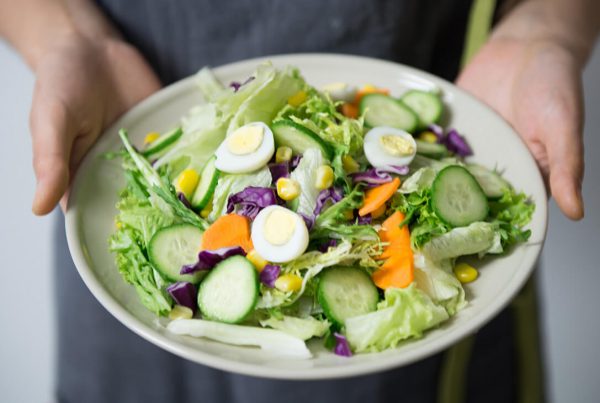So you started working out and lowered your overall body fat.
First off, congratulations should be in order!
Achieving and maintaining a healthy weight despite life’s occasional curveballs is something that you should be proud of. The positive changes in your body composition is proof that your efforts have finally paid off!
So where do you go from here?
Your next goal may be one of the following:
I want a huge, action star physique.
I want to achieve a leaner, more athletic look.
I want to increase my functional strength and achieve new PR’s in my lifts
Whether your goal is gaining strength or sculpting your body to your desired physique, the approach boils down to same thing — gaining muscle.
Eating for Well-Defined Muscles

As previously discussed in an article published about how much muscle you can gain in a month, the three main pillars of muscle growth are: nutrition, exercise, and hormones.
In this article, we’ll put the spotlight on nutrition and address your most frequently asked questions about what to eat in order to build muscle.
Let’s get started!
People use lean body mass and muscle mass interchangeably. Are they similar or different from each other?
Yes, lean body mass and muscle mass are two different things.
Essentially, all muscle is “lean” meaning it is primarily composed of proteins, which are lean. However, things start to get more confusing when some folks use lean body mass and skeletal muscle mass interchangeably.
Lean body mass (LBM), also known as lean mass, refers to your total weight minus all the weight comprised of fat mass. This includes your organs, your skin, your bones, your body water, and your muscles.
On the other hand, skeletal muscle mass (SMM) is a part of your LBM, but it is the part that is referring to the specific muscles used that are controlled voluntarily to produce movement and maintain posture. When you’re thinking about gaining muscle, you are actually referring more specifically to your SMM. This is what we want to track and here’s why:
Apart from changes in your SMM, a gain in your LBM numbers can also be a result of water gain. Water gain can occur from bloating or eating salty foods but also from swelling from injury or disease. That’s why you cannot attribute a increase to LBM numbers completely to muscle gains.
You can learn more about the distinction between the two in Lean Body Mass and Muscle Mass: What’s the Difference?
Now that we cleared that up, let’s dig into the facts and findings about muscle gains through diet and nutrition.
Is the hype about protein justified when it comes to bigger muscle gains?

Yes, to an extent. It’s an established fact that eating high quality protein within close temporal proximity (immediately before and within 24 hours after) of resistance exercise is recommended to increase muscle gains.
The strain of repetition when you perform resistance exercise tears the muscle fibers, and the protein intake (although macronutrients like carbs and fat play a role, too) provides the resources to rebuild the newly torn muscles into something bigger and stronger.
It’s also worth noting that amino acids are the building blocks of protein, and as you most likely already know, your muscle is made up of these macronutrients. As we’ve emphasized in Why Everyone Needs Protein — Think of your muscles as the house itself while the amino acids that make up protein are the bricks.
The good news is that your body can manufacture a huge chunk of these amino acids. The not-so-good news is that some of them, also known as essential amino acids (EAA), can’t be made by the body. You have to get your EAAs from food sources.
In short, you need to follow a high protein meal plan that contains mixed amounts of these EAAs to help ensure increase muscle protein synthesis (MPS)
How do I know if I have enough protein intake to promote MPS?

As of June 2017, the International Society of Sports Nutrition (ISSN) recommends an overall daily protein intake in the range of 1.4–2.0 g protein/kg body weight/day (g/kg/d) for building and maintaining muscle mass. Remember, your specific dietary needs depend on the amount of muscle mass you have as well as the type and intensity of your physical activity
With these figures in mind, let’s say you weigh 125 pounds (57 kilos), and you’re working to increase your LBM. You would need 57 x 1.4- 2.0, or 79.8 – 114 grams of protein a day.
This may sound like a lot but it’s not. A cup (140 grams) of chicken contains 43 grams of protein. Meanwhile, a can of tuna can contain as much as 49 grams. Eating a cup of chicken and a can of tuna, you’d almost entirely meet your protein needs. If you add in a glass of 2% milk (another 9-10 grams of protein), you’ve already hit your goal.
Below is a rough dietary guideline based on activity level:
- 0.8-1.2 g/kg for regular activity
- 1.2-1.5 g/kg for endurance athletes
- 1.5-1.8 g/kg for strength/power athletes
If counting grams of protein for the day is not your thing, researchers have recommend an intake of about 20-40 grams of whey protein following a heavy bout of whole body resistance exercise to promote greater muscle recovery. The results stressed that the traditional 20 grams of whey supplement after working out did not promote as much MPS as the 40 grams of protein.
Can I build more muscle from eating too much protein?
Not really.
Researchers found that eating five times the recommended daily allowance of protein has no effect on body composition in resistance-trained individuals who otherwise maintain the same training regimen. That means that doubling or tripling your protein intake doesn’t translate to greater muscle gain after exercise.
It’s also worth noting that this is one of the first interventional study to demonstrate that eating a high protein meals does not result in an increase in fat mass.
Will too much protein hurt my kidneys?
While protein restriction may be appropriate for treatment of existing kidney disease, some research has shown high protein intake in healthy individuals to not be harmful to kidney function. Unlike extra stores of fat that the body is so keen about in holding on, the amino acids in protein are more likely to be excreted via the urine when not in use.
With that in mind, there are certainly risks associated with consuming too much protein so it’s wise to keep your intake in check.
So what our conclusion here? Eating more protein makes you feel fuller longer, can help curb overeating, and is essential for recovery and growth but don’t forget equally important nutrients like carbohydrates and fats for proteins when hitting your daily caloric goals (we’ll address this issue later).
Meat is often considered an excellent source of protein. So should I eat more meat to gain muscle? What if I’m on a plant-based diet?

Good question!
Sure, meat provides complete sources of proteins that are rich in essential amino acids so it truly is an excellent source of protein.
In a small study comparing the effects of resistance training-induced changes in body composition and skeletal muscle among two groups — older men with an omnivorous (meat-containing) diet and those with lacto-ovo vegetarian (meat-free) diet, the researchers found that the omnivorous diet resulted to greater gains in fat-free mass and skeletal muscle mass when combined with resistance training than the vegetarian-diet group.
Another study of 74 men and women who had type 2 diabetes — one half on a vegetarian diet and the other half on a conventional diabetic diet — were assessed at three and six months to measure how much weight they had lost. The study concluded that the vegetarian diet was almost twice as effective at reducing weight compared with the conventional diet.
But here’s the caveat — The greater weight loss seen in people on the vegetarian diet was also accompanied by greater muscle loss, particularly when maintaining their normal exercise routine. This might be an unwanted outcome and a disadvantage when compared with the omnivorous diet.
Finally, another research study examining the relationship between the type of protein intake and the level of muscle mass in healthy omnivorous and vegetarian Caucasian women found:
“A vegetarian diet is associated with a lower muscle mass index than is an omnivorous diet at the same protein intake. A good indicator of muscle mass index in women seems to be animal protein intake.”
Take note, however, that these findings do not automatically mean that animal protein is necessary to develop muscle mass.
As we mentioned in this in-depth article on whether or not you need to eat meat to gain muscle, the findings indicate that vegetarians might have a harder time getting adequate protein intake. As a result, they may not be receiving the same quality of amino acid variety to support muscle maintenance/growth as meat-eaters. This issue can be addressed by adding more variety in your diet or through supplementation.
So what about my intake of carbs and fat?

If you want to build muscle, increasing your dietary protein intake makes sense. However, this doesn’t mean that you should disregard carbs and fats.
For one, carbohydrates help replace glycogen and aids in enhancing the role of insulin when it comes to transporting nutrients into the cells, including your muscles. Combining protein and carbs also has the added advantage of limiting post- exercise breakdown and promoting growth.
In a nutshell, a diet balanced in protein, carbs, fats, and fiber is the most effective way to build muscle.
How about the ketogenic diet? Can it help me gain more muscle mass?

Most likely. The main premise of a ketogenic diet is to opt for high fat, moderate protein, and a very low carb diet.
In an 11-week study of men who performed resistance training three times a week, the researchers found that lean body mass increased significantly in subjects who consumed a very low carb, ketogenic diet (VLCKD). Significant fat loss was also observed amongst the VLCKD subjects.
Does “when I eat” if I want to build muscle?

For decades, the idea of nutrient timing (eating certain macronutrients at specific times like before, during, or after exercise) and meal scheduling has sparked a lot of interest, excitement, and confusion.
A good example of nutrient timing is the idea of the anabolic window, also known as a period of time after exercise, where our body is supposedly primed for nutrients to help recovery and growth.
However, a review of related literature revealed that while protein intake after workout helps muscle growth, it may persist long after training.
If you’re going to ask the ISSN, meeting the total daily intake of protein, preferably with evenly spaced protein feedings (approximately every 3 h during the day), should be given more emphasis for exercising individuals.
They also state that ingesting a 20–40 g protein dose (0.25–0.40 g/kg body mass/dose) of a high-quality source every 3 to 4 hours appears to favorably affect MPS rates over other dietary patterns, which allows for improved body composition and performance outcomes.
In short, it’s more important to focus on the total amount of protein and carbohydrate you eat over the course of the day than worry about nutrient timing strategies.
The Takeaway

In summary, here’s what you need to remember when it comes to eating in order to gain muscle:
- Muscle gains are hard to come by if you don’t complement your exercise training with the right nutrition. Besides acting as fuel for physical activity, eating right helps in muscle recovery and development of new muscle tissue.
- Pay special attention to your protein intake in order to build muscle. Helpful figures to remember are 1.4–2.0 g protein/kg body weight/day (g/kg/d) depending on your body composition, activity type, and activity intensity.
- There’s been a lot of talk about a specific amino acids and anabolic (muscle-building) superpowers. However, it’s still important to consume different sources of protein when you can and not just focus on a single protein source. Plus, remember that your body needs carbs and fat too.
- Do not worry about when is the best time to eat your steak. Eating a portion of lean protein with some fiber-rich carbs and fat every meal is a good way to help your body repair and rebuild muscle after resistance exercise. As much as possible, increase make sure to complement your exercise with the appropriate nutrients to promote muscle recovery and growth.
- If you’re on a plant-based diet, make sure you’re incorporating a wide variety of protein-rich plants to ensure that you’re getting the full range of amino acids. You may have to consider plant-based protein powder supplementation.
Remember, people have different goals when it comes to working out and gaining muscle — from aesthetics to improved sports performance to feeling better about yourself. That means there is no “one-size-fits-all” approach.
Whatever your goal, it all begins with one small step at a time. What changes are you going to make today?
***
Kyjean Tomboc is a nurse turned freelance healthcare copywriter and UX researcher. After experimenting with going paleo and vegetarian, she realized that it all boils down to eating real food.
Source: https://inbodyusa.com/blogs/inbodyblog/what-to-eat-in-order-to-gain-muscle/




